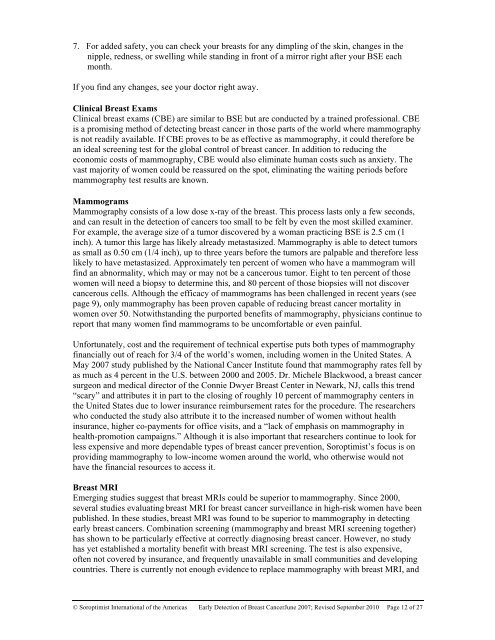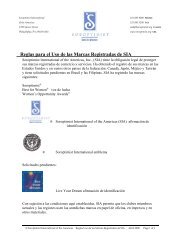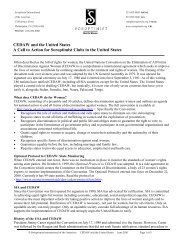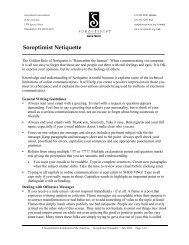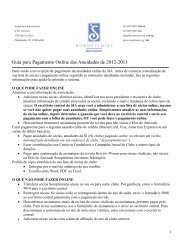Early Detection of Breast Cancer - Soroptimist
Early Detection of Breast Cancer - Soroptimist
Early Detection of Breast Cancer - Soroptimist
Create successful ePaper yourself
Turn your PDF publications into a flip-book with our unique Google optimized e-Paper software.
7. For added safety, you can check your breasts for any dimpling <strong>of</strong> the skin, changes in the<br />
nipple, redness, or swelling while standing in front <strong>of</strong> a mirror right after your BSE each<br />
month.<br />
If you find any changes, see your doctor right away.<br />
Clinical <strong>Breast</strong> Exams<br />
Clinical breast exams (CBE) are similar to BSE but are conducted by a trained pr<strong>of</strong>essional. CBE<br />
is a promising method <strong>of</strong> detecting breast cancer in those parts <strong>of</strong> the world where mammography<br />
is not readily available. If CBE proves to be as effective as mammography, it could therefore be<br />
an ideal screening test for the global control <strong>of</strong> breast cancer. In addition to reducing the<br />
economic costs <strong>of</strong> mammography, CBE would also eliminate human costs such as anxiety. The<br />
vast majority <strong>of</strong> women could be reassured on the spot, eliminating the waiting periods before<br />
mammography test results are known.<br />
Mammograms<br />
Mammography consists <strong>of</strong> a low dose x-ray <strong>of</strong> the breast. This process lasts only a few seconds,<br />
and can result in the detection <strong>of</strong> cancers too small to be felt by even the most skilled examiner.<br />
For example, the average size <strong>of</strong> a tumor discovered by a woman practicing BSE is 2.5 cm (1<br />
inch). A tumor this large has likely already metastasized. Mammography is able to detect tumors<br />
as small as 0.50 cm (1/4 inch), up to three years before the tumors are palpable and therefore less<br />
likely to have metastasized. Approximately ten percent <strong>of</strong> women who have a mammogram will<br />
find an abnormality, which may or may not be a cancerous tumor. Eight to ten percent <strong>of</strong> those<br />
women will need a biopsy to determine this, and 80 percent <strong>of</strong> those biopsies will not discover<br />
cancerous cells. Although the efficacy <strong>of</strong> mammograms has been challenged in recent years (see<br />
page 9), only mammography has been proven capable <strong>of</strong> reducing breast cancer mortality in<br />
women over 50. Notwithstanding the purported benefits <strong>of</strong> mammography, physicians continue to<br />
report that many women find mammograms to be uncomfortable or even painful.<br />
Unfortunately, cost and the requirement <strong>of</strong> technical expertise puts both types <strong>of</strong> mammography<br />
financially out <strong>of</strong> reach for 3/4 <strong>of</strong> the world’s women, including women in the United States. A<br />
May 2007 study published by the National <strong>Cancer</strong> Institute found that mammography rates fell by<br />
as much as 4 percent in the U.S. between 2000 and 2005. Dr. Michele Blackwood, a breast cancer<br />
surgeon and medical director <strong>of</strong> the Connie Dwyer <strong>Breast</strong> Center in Newark, NJ, calls this trend<br />
“scary” and attributes it in part to the closing <strong>of</strong> roughly 10 percent <strong>of</strong> mammography centers in<br />
the United States due to lower insurance reimbursement rates for the procedure. The researchers<br />
who conducted the study also attribute it to the increased number <strong>of</strong> women without health<br />
insurance, higher co-payments for <strong>of</strong>fice visits, and a “lack <strong>of</strong> emphasis on mammography in<br />
health-promotion campaigns.” Although it is also important that researchers continue to look for<br />
less expensive and more dependable types <strong>of</strong> breast cancer prevention, <strong>Soroptimist</strong>’s focus is on<br />
providing mammography to low-income women around the world, who otherwise would not<br />
have the financial resources to access it.<br />
<strong>Breast</strong> MRI<br />
Emerging studies suggest that breast MRIs could be superior to mammography. Since 2000,<br />
several studies evaluating breast MRI for breast cancer surveillance in high-risk women have been<br />
published. In these studies, breast MRI was found to be superior to mammography in detecting<br />
early breast cancers. Combination screening (mammography and breast MRI screening together)<br />
has shown to be particularly effective at correctly diagnosing breast cancer. However, no study<br />
has yet established a mortality benefit with breast MRI screening. The test is also expensive,<br />
<strong>of</strong>ten not covered by insurance, and frequently unavailable in small communities and developing<br />
countries. There is currently not enough evidence to replace mammography with breast MRI, and<br />
© <strong>Soroptimist</strong> International <strong>of</strong> the Americas <strong>Early</strong> <strong>Detection</strong> <strong>of</strong> <strong>Breast</strong> <strong>Cancer</strong>June 2007; Revised September 2010 Page 12 <strong>of</strong> 27


